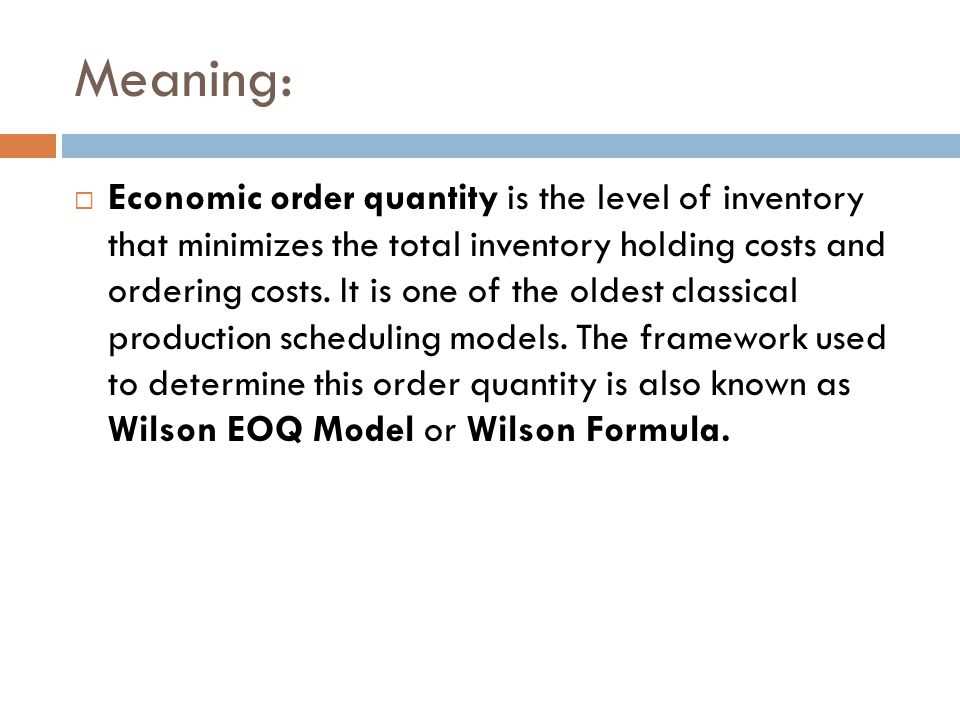Economic Order Quantity: Importance and Meaning
The economic order quantity (EOQ) is a key concept in inventory management that helps businesses determine the optimal quantity of inventory to order at any given time. It is a mathematical formula that takes into account various factors such as demand, holding costs, and ordering costs to find the balance between carrying too much inventory and running out of stock.
The importance of EOQ lies in its ability to minimize costs and maximize efficiency in inventory management. By calculating the EOQ, businesses can avoid overstocking, which ties up capital and incurs holding costs, as well as understocking, which leads to lost sales and dissatisfied customers.
Furthermore, EOQ helps businesses streamline their ordering process. By determining the optimal order quantity, businesses can reduce the number of orders placed, which in turn reduces ordering costs such as transportation and paperwork. This not only saves time and resources but also improves overall operational efficiency.
Moreover, EOQ provides businesses with a framework for making informed decisions about inventory management. By considering factors such as demand patterns, lead times, and costs, businesses can make data-driven decisions that optimize their inventory levels and improve their bottom line.
Factors to Consider

There are several factors that businesses need to consider when calculating EOQ:
- Carrying Costs: Carrying costs refer to the expenses associated with holding inventory, such as storage costs, insurance, and obsolescence. By considering these costs, businesses can determine the optimal order quantity that minimizes carrying costs.
- Ordering Costs: Ordering costs include expenses related to placing and receiving orders, such as administrative costs and transportation costs. By taking these costs into account, businesses can determine the optimal order quantity that minimizes ordering costs.
- Cost Savings: By optimizing the order quantity, businesses can minimize carrying costs and ordering costs, leading to overall cost savings.
- Efficient Inventory Management: EOQ helps businesses maintain the right level of inventory, avoiding stockouts and excess inventory. This leads to improved customer satisfaction and efficient operations.
- Improved Cash Flow: By optimizing the order quantity, businesses can free up cash that would otherwise be tied up in excess inventory. This can improve cash flow and provide more financial flexibility.
Benefits of Economic Order Quantity
The Economic Order Quantity (EOQ) is a widely used inventory management technique that helps businesses determine the optimal order quantity to minimize costs and maximize efficiency. By calculating the EOQ, businesses can strike a balance between carrying costs and ordering costs, leading to several benefits:
1. Cost Reduction
One of the main benefits of implementing the EOQ is cost reduction. By determining the optimal order quantity, businesses can minimize holding costs, which include expenses such as storage, insurance, and depreciation. Additionally, the EOQ helps to minimize ordering costs, which include expenses such as purchase order processing and transportation. By reducing these costs, businesses can improve their overall profitability.
2. Inventory Optimization
The EOQ helps businesses optimize their inventory levels by ensuring that they have enough stock to meet customer demand without overstocking. Overstocking can lead to increased holding costs and the risk of obsolescence, while understocking can result in lost sales and dissatisfied customers. By using the EOQ, businesses can strike the right balance and maintain optimal inventory levels.
3. Improved Cash Flow
Implementing the EOQ can also lead to improved cash flow. By reducing holding costs and optimizing inventory levels, businesses can free up cash that would otherwise be tied up in excess inventory. This allows businesses to allocate their financial resources more efficiently and invest in other areas of the business, such as marketing or research and development.
Implementing Economic Order Quantity
Implementing Economic Order Quantity (EOQ) can have significant benefits for businesses in terms of cost savings and improved efficiency. Here are some steps to consider when implementing EOQ:
- Analyze historical data: Start by analyzing your company’s historical data on sales, inventory levels, and ordering costs. This will help you determine the optimal order quantity and reorder point.
- Calculate EOQ: Use the EOQ formula to calculate the optimal order quantity. The formula takes into account the annual demand, ordering cost, and holding cost.
- Set reorder point: Determine the reorder point, which is the inventory level at which a new order should be placed. This is usually set at the EOQ minus the lead time demand.
- Implement inventory management system: Invest in an inventory management system that can track inventory levels, monitor demand, and generate reorder alerts. This will help automate the ordering process and minimize the risk of stockouts or excess inventory.
- Monitor and adjust: Continuously monitor your inventory levels, sales data, and reorder points. Make adjustments as needed to optimize your inventory management strategy and ensure that you are achieving the desired cost savings.
By implementing EOQ, businesses can minimize inventory holding costs, reduce ordering costs, and improve overall supply chain efficiency. It is an effective tool for optimizing inventory management and ensuring that the right quantity of products is ordered at the right time.

Emily Bibb simplifies finance through bestselling books and articles, bridging complex concepts for everyday understanding. Engaging audiences via social media, she shares insights for financial success. Active in seminars and philanthropy, Bibb aims to create a more financially informed society, driven by her passion for empowering others.
